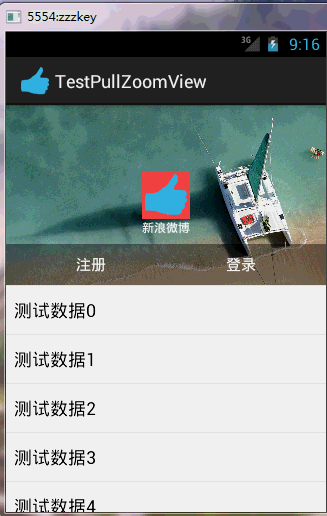
·您现在的位置: 云翼网络 >> 文章中心 >> 网站建设 >> app软件开发 >> Android开发 >> 新浪微博第三方登录界面上下拉伸图片之第三方开源PullToZoomListViewEx(一)
- 六款值得推荐的android(安卓)开源框架简介
- 举例讲解Android中ViewPager中的PagerTitleStrip子控件
- 使用Fragment来处理Andoird app的UI布局的实例分享
- Android使用线程获取网络图片的方法
- 深入Android 五大布局对象的应用
- Android App中使用Pull解析XML格式数据的使用示例
- Android仿微信底部菜单栏功能显示未读消息数量
- Android编程之在SD卡上进行文件读写操作实例详解
- Android layout_weight使用方法及实例
- Android实现音量调节的方法
- Android程序开发之ListView实现横向滚动(带表头与固定列)
- Android中ImageView用法实例分析
- Android中ViewPager和Fragment的使用
- Android ViewPager相册横向移动的实现方法
- Android版的股票行情K线图开发
- Android的Glide库加载图片的用法及其与Picasso的对比
- Android开发之开发者头条(二)实现左滑菜单
- Android平台中实现数据存储的5种方式
- android如何设置小区广播默认信道(50与60并支持双卡)
- Android开发中避免应用无响应的方法(Application Not Responding、ANR)
- Android中的Shape和Selector的结合使用实例
- android 网络连接处理分析
- Android开发之完成登陆界面的数据保存回显操作实例
- Android ExpandableListView展开列表控件使用实例
- Android遍历所有文件夹和子目录搜索文件
- Android应用程序签名步骤及相关知识介绍
- Android应用开发中自定义ViewGroup的究极攻略
- 详解Java编程中的反射在Android开发中的应用
- unity3d发布apk在android虚拟机中运行的详细步骤(unity3d导出android apk)
- Android简单的利用MediaRecorder进行录音的实例代码
新浪微博第三方登录界面上下拉伸图片之第三方开源PullToZoomListViewEx(一)

Android PullZoomView是github上面的一个第三方开源项目,该项目实现的功能被新浪微博的移动端广泛使用,其效果就是,当用户在下拉过程中,头部的图片会有一定的拉伸,当用户松开时候,图片又收缩复位,下载地址:https://github.com/Frank-Zhu/PullZoomView
PullZoomView要实现两类,一类是典型的Android ListView,另外一类是Android 的scroll view。本文先介绍PullZoomView在ListView上的实现:PullToZoomListViewEx。
首先需要把PullToZoomListViewEx像ListView一样写进布局:
<RelativeLayout xmlns:android="http://schemas.android.com/apk/res/android" xmlns:tools="http://schemas.android.com/tools" android:layout_width="match_parent" android:layout_height="match_parent" tools:context="com.zzw.testpullzoomview.MainActivity" > <com.ecloud.pulltozoomview.PullToZoomListViewEx xmlns:custom="http://schemas.android.com/apk/res-auto" android:id="@+id/listView" android:layout_width="match_parent" android:layout_height="match_parent" custom:headerView="@layout/head_view" custom:zoomView="@layout/head_zoom_view" /> </RelativeLayout>
需要注意的是,需要定义一个headerView:
custom:headerView="@layout/head_view" <RelativeLayout xmlns:android="http://schemas.android.com/apk/res/android" android:id="@+id/layout_view" android:layout_width="match_parent" android:layout_height="match_parent" android:layout_gravity="bottom" android:gravity="bottom"> <ImageView android:id="@+id/iv_user_head" android:layout_width="wrap_content" android:layout_height="wrap_content" android:layout_centerInParent="true" android:background="@android:color/holo_red_light" android:src="@drawable/ic_launcher" /> <TextView android:id="@+id/tv_user_name" android:textSize="sp" android:layout_width="wrap_content" android:layout_height="wrap_content" android:layout_below="@id/iv_user_head" android:layout_centerHorizontal="true" android:text="新浪微博" android:textColor="#ffffff" /> <LinearLayout android:id="@+id/ll_action_button" android:layout_width="match_parent" android:layout_height="wrap_content" android:background="#" android:layout_alignParentBottom="true" android:padding="dip"> <TextView android:id="@+id/tv_register" android:layout_width="match_parent" android:layout_height="wrap_content" android:text="注册" android:layout_weight="" android:textSize="sp" android:gravity="center" android:layout_gravity="center" android:textColor="#ffffff" /> <TextView android:id="@+id/tv_login" android:layout_width="match_parent" android:layout_height="wrap_content" android:text="登录" android:layout_weight="" android:textSize="sp" android:gravity="center" android:layout_gravity="center" android:textColor="#ffffff" /> </LinearLayout> </RelativeLayout>
此处的headerView是位于PullToZoomListViewEx头部的一个子布局,里面定义一些控件将出现在PullToZoomListViewEx的头部,但此处的headerView并不会缩放,只是可以看到此处的headerView在随着下拉过程中移位。
而定义的custom:zoomView:
custom:zoomView="@layout/head_zoom_view" <?xml version="." encoding="utf-"?> <ImageView xmlns:android="http://schemas.android.com/apk/res/android" android:id="@+id/imageView" android:layout_width="match_parent" android:layout_height="match_parent" android:layout_gravity="center_horizontal" android:scaleType="centerCrop" android:src="@drawable/a" />
head_zoom_view其实就是简单的放一张图片。
则是真正的要缩放伸展的View,此处通常会放置一张图片,在用户下拉过程中滑动缩放,产生奇妙的视觉效果。
在一定程度上讲,zoomView是衬托在headerView底下的。headerView是一个正常显示的Android View布局,而zoomView则是可以产生动态缩放和收缩效果的特殊zoom View。
写一个完整的例子加以说明。
Java代码:
package com.zzw.testpullzoomview;
import com.ecloud.pulltozoomview.PullToZoomListViewEx;
import android.app.Activity;
import android.os.Bundle;
import android.util.DisplayMetrics;
import android.util.Log;
import android.view.View;
import android.widget.AbsListView;
import android.widget.AdapterView;
import android.widget.AdapterView.OnItemClickListener;
import android.widget.ArrayAdapter;
public class MainActivity extends Activity {
@Override
protected void onCreate(Bundle savedInstanceState) {
super.onCreate(savedInstanceState);
setContentView(R.layout.activity_main);
PullToZoomListViewEx listView = (PullToZoomListViewEx) findViewById(R.id.listView);
String data[] = new String[];
for (int i = ; i < data.length; i++) {
data[i] = "测试数据" + i;
}
listView.setAdapter(new ArrayAdapter<String>(this, android.R.layout.simple_list_item_, data));
listView.getPullRootView().setOnItemClickListener(new OnItemClickListener() {
@Override
public void onItemClick(AdapterView<?> parent, View view, int position, long id) {
Log.d("position", "getPullRootView--->position = " + position);
}
});
listView.setOnItemClickListener(new OnItemClickListener() {
@Override
public void onItemClick(AdapterView<?> parent, View view, int position, long id) {
Log.d("position", "position = " + position);
}
});
setPullToZoomListViewExHeaderLayoutParams(listView);
}
// 设置头部的View的宽高。
private void setPullToZoomListViewExHeaderLayoutParams(PullToZoomListViewEx listView) {
DisplayMetrics localDisplayMetrics = new DisplayMetrics();
getWindowManager().getDefaultDisplay().getMetrics(localDisplayMetrics);
int mScreenHeight = localDisplayMetrics.heightPixels;
int mScreenWidth = localDisplayMetrics.widthPixels;
AbsListView.LayoutParams localObject = new AbsListView.LayoutParams(mScreenWidth,
(int) (.f * (mScreenWidth / .F)));
listView.setHeaderLayoutParams(localObject);
}
}
以上所述是本文关于新浪微博第三方登录界面上下拉伸图片之第三方开源PullToZoomListViewEx(一)的全部叙述,希望大家喜欢,下篇给大家介绍新浪微博第三方登录界面上下拉伸图片之第三方开源PullToZoomListViewEx(二),希望大家继续关注。
- Android App中制作仿MIUI的Tab切换效果的实
- Android 自定义View 密码框实例代码
- Android实现短信验证码自动填写功能
- Android编程之控件状态配置文件实例
- Android ListView获得选项中的值
- Android使用ContentResolver搜索手机通讯录
- android实现获取有线和无线Ip地址的方法